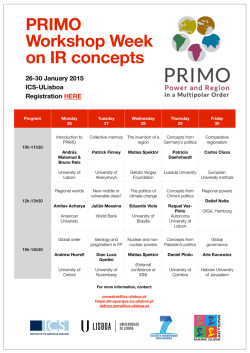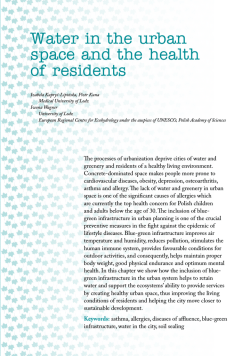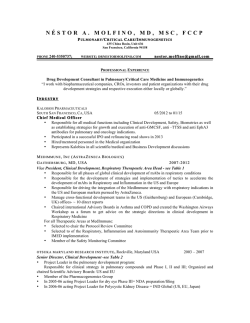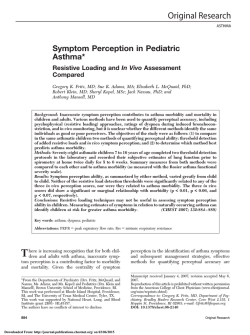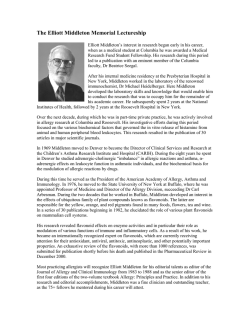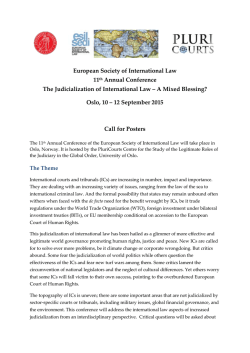
What`s new - Global Initiative for Asthma
Global Initiative for Asthma (GINA) What’s new in GINA 2015? GINA Global Strategy for Asthma Management and Prevention © Global Initiative for Asthma What’s new in GINA 2015 (1) Add-on tiotropium by soft-mist inhaler is a new ‘other controller option’ for Steps 4 and 5, in patients ≥18 years with history of exacerbations Tiotropium was previously described in GINA as an add-on option on the basis of clinical trial evidence. It is now included in recommendations and the stepwise figure following approval for asthma by a major regulator. © Global Initiative for Asthma GINA 2015 – changes to Steps 4 and 5 STEP 5 STEP 4 PREFERRED CONTROLLER CHOICE STEP 1 STEP 2 Low dose ICS Other controller options RELIEVER Consider low dose ICS Leukotriene receptor antagonists (LTRA) Low dose theophylline* As-needed short-acting beta2-agonist (SABA) STEP 3 Low dose ICS/LABA* Med/high ICS/LABA Med/high dose ICS Add tiotropium# Low dose ICS+LTRA High dose ICS + LTRA (or + theoph*) (or + theoph*) Refer for add-on treatment e.g. anti-IgE Add tiotropium# Add low dose OCS As-needed SABA or low dose ICS/formoterol** *For children 6-11 years, theophylline is not recommended, and preferred Step 3 is medium dose ICS **For patients prescribed BDP/formoterol or BUD/formoterol maintenance and reliever therapy # Tiotropium by soft-mist inhaler is indicated as add-on treatment for patients with a history of exacerbations; it is not indicated in children <18 years. GINA 2015, Box 3-5, Steps 4 and 5 © Global Initiative for Asthma What’s new in GINA 2015 (2) Management of asthma in pregnancy Monitor for respiratory infections and manage them appropriately, because of increased risk of exacerbations Management of asthma during labor and delivery • Give usual controller, and SABA if needed, e.g. following hyperventilation • Watch for neonatal hyperglycaemia (especially in preterm babies) if high doses of SABA used in previous 48 hours Breathing exercises Evidence level down-graded from A to B following review of quality of evidence and a new meta-analysis (Freitas, Cochrane 2013) The term ‘breathing exercises’ is used, rather than ‘breathing techniques’, to avoid any perception that a specific technique is recommended © Global Initiative for Asthma What’s new in GINA 2015 (3) Mild or moderate exacerbations Dry powder inhalers as effective as puffer and spacer for delivery of SABA in worsening asthma or exacerbations (Selroos, Ther Deliv. 2014) Note that studies did not include patients with severe acute asthma Life-threatening or severe acute asthma in primary care While arranging transfer to acute care facility, give inhaled ipratropium bromide as well as SABA, systemic corticosteroids, and oxygen if necessary Pre-school children with acute exacerbations or wheezing episodes Clarification that parent-administered oral steroids or high dose ICS are not generally recommended for pre-school children with acute wheezing or exacerbations • Respiratory infections and wheezing occur very frequently in this age-group • There is substantial concern about the risk of systemic side-effects, especially with repeated use A new flow-chart for pre-school children is included in GINA 2015 © Global Initiative for Asthma Managing exacerbations or wheezing in pre-schoolers For more detail, see GINA 2015 slide kit GINA 2015, Box 6-8 © Global Initiative for Asthma Other changes for clarification in GINA 2015 update Assessment of risk factors: over-usage of SABA High usage of SABA is a risk factor for exacerbations (Patel et al, CEA 2013) Very high usage (e.g. >200 doses/month) is a risk factor for asthma-related death (Haselkom, JACI 2009) Beta-blockers and acute coronary events If cardioselective beta-blockers are indicated for acute coronary events, asthma is not an absolute contra-indication. These medications should only be used under close medical supervision by a specialist, with consideration of the risks for and against their use Asthma-COPD Overlap Syndrome (ACOS) The aims of the chapter are mainly to assist clinicians in primary care and non-pulmonary specialties in diagnosing asthma and COPD as well as ACOS, and to assist in choosing initial treatment for efficacy and safety A specific definition cannot be provided for ACOS at present, because of the limited populations in which it has been studied ACOS is not considered to represent a single disease; it is expected that further research will identify several different underlying mechanisms © Global Initiative for Asthma Other changes in GINA 2015 The work of GINA is now supported only by income generated from the sale of GINA products GINA resources are available at www.ginasthma.org © Global Initiative for Asthma
© Copyright 2024

